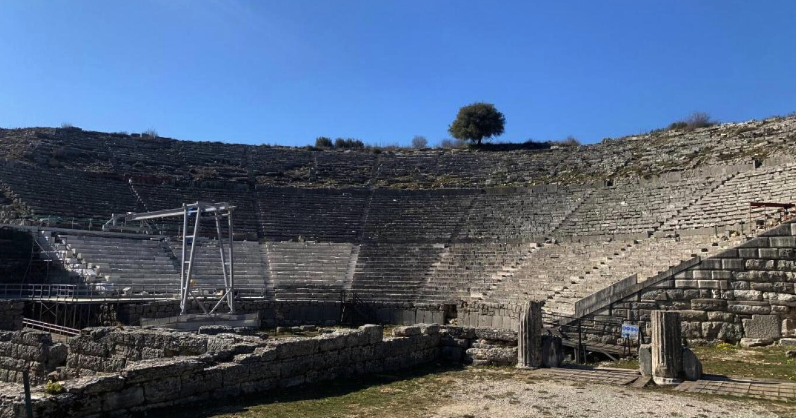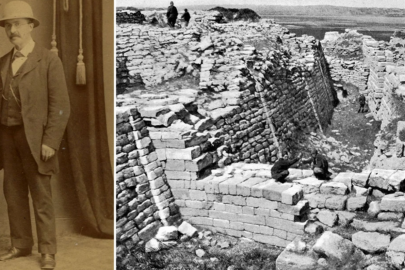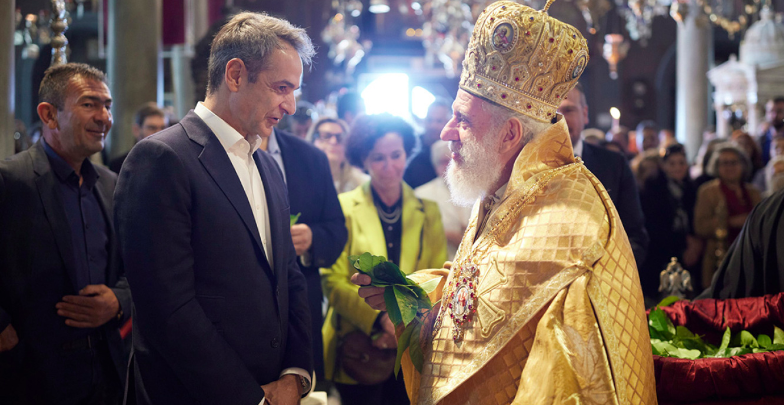With the restoration of the middle diaspora, work on the ancient theatre of Dodonis will continue as part of the strategic plan for its conservation.
This plan includes the history of the interventions in the theatre from 2000 to the present day, the evaluation of the restoration interventions in the lower dome, the updated recording of the pathology of each individual area of the monument, the analysis – verification of the geometry of the monument based on previous studies and the latest data, which emerged during the execution of the project, the temporal prioritisation of the works based on the experience gained and the restoration principles applied to the lower dome.
The Minister of Culture Lina Mendoni described the project of restoration of the ancient theatre of Dodoni as one of the most complex and difficult projects, which has been undertaken for years, to bring over the competent services of the Ministry of Culture as the limestone with which it has been built crumbled, due to the environmental conditions prevailing in the area.
“The last phase of the project for the restoration and promotion of the ancient theatre of Dodoni, with a budget of 4,790,500 euros, funded by the Regional Operational Programme of Epirus ESPA 2014-2020, has been completed as far as the lower hollow is concerned.
In the lower hollow, the original geometry of the theatre was adequately documented through the identification of original parts and the carving of the natural rock.
Geometry has been a constant concern, either as a restoration of geometric regularity or as a restoration of the original geometry of the theatre in the intervention areas, in accordance with the scientific evidence from the general study of the monument, as well as with what emerged during the development of the project.
The results obtained during the study – restoration of the lower hollow are the indicator of the situation, which prevails in the middle hollow, in which it is planned to start work immediately with funding from the Epirus 2021-2027.
The ancient theatre of Dodoni is part of the Cultural Route of Epirus, which is implemented by the Ministry of Culture in cooperation with the Region of Epirus and also includes the ancient theatres of Gitana, Amvrakia, Kassopi, Nikopolis” notes the Minister of Culture.
To date, the restoration of the lower hollow of the theatre, the stands (1st to 9th) and the first diazoma, in the section of the four stands from the east, has been implemented. As regards the history of the interventions, in the years 2002-2007, maintenance work was carried out throughout the lower part of the theatre.
In 2008-2010, pilot implementation work was completed on the theatre’s fixation and restoration design, from the first eastbound grandstand of the lower concourse and the adjacent eastbound riser.
In 2011, the restoration of the stands from K2A to K6A was started in stages, one by one, and was completed in 2015. As part of the 2014-2020 project, the restoration of the stands from K7A to K9A and the adjacent western riser was carried out and the restoration of the lower zone of the cavern was completed.
The timing of the next works is as follows provides for the restoration of the middle zone (stands, risers and external staircases) starting from stand 5B with the aim of bringing geometric regularity to this zone of the monument; then the restoration of the apse will take place. This is the most extensive part of the monument, which has not undergone any structural interventions, as it was not included in the 1960 restoration work.
With regard to the pathology of the second zone, the apse and the retaining walls, the documentation has shown that this is a part of the monument that has suffered a dramatic loss of material, mainly in the peripheral areas, due to the collapse of the lateral retaining walls that held up the supporting fillings at the periphery of the hollow.
The intervention in the epitheatre cannot, at present, be adequately determined. However, the studies and work carried out on the lower pit, and planned to be applied to the middle pit, form the basis and reservoir of information necessary for the final management of the epithet.
The ancient theatre of Dodoni is located at the north-western end of the sanctuary of the same name. It dates back to the beginning of the 3rd century BC during the reign of Pyrrhus (296-272 BC).
The immediate need for the restoration of the ancient theatre and the enhancement of the archaeological site of Dodoni, led to the inclusion of the works in the Credit Management Fund for the execution of archaeological projects of the Ministry of Culture, in 2000, and the start of the restoration work.
The current form of the monument is due to the consolidation – restoration interventions carried out in the 1960s and 1970s. The theatre consists of the orchestra, the stage and the hollow. High risers to the east, south and west surround and support the hollow.
Reuters: Ukraine abruptly withdrew from an imminent agreement with Russia in the Black Sea
The hollow is divided into three sections with 55 rows of seats in total. The two lower sections are divided by stairs into 9 tiers and the upper one into 18 tiers. The ancient theatre of Dodoni hosted performances from 1960 until the summer of 1999, when the Ministry of Culture decided to terminate its concession in order to carry out maintenance and restoration work.
At the start of the restoration work, the original geometry of the monument was investigated. Since 2002 and for 22 years, the services of the Ministry of Culture, academics and external collaborators have worked intensively and systematically to restore the lower part of the theatre.






































